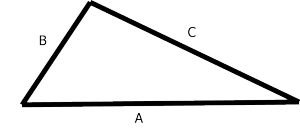Studying at PUC-Rio there was a course called Probabilistic Models given by the Telecommunication Engineering Department, which was well-known for their creative approach to student evaluation. In one of those exams there was a question described below:
Suppose you break a stick in a random point of its length, from the two pieces you have now, choose the largest piece and break again randomly. What is the likelihood of you form a triangle with the three pieces?
Before you go nuts looking in Google, note that this problem is slightly different from the "three stick triangle problem" , in ours the second time you choose to break the biggest piece which is different of breaking a stick into 3 pieces directly. Warning: if you want to try to solve it, stop reading now. There are two ways to solve this problem, a computational way, that was not the case at the time, and an analytical form. The analytic form is interesting but requires further mathematical knowledge. But a computational form is available for anyone who knows how to program as in the Python script below.
from random import random
def isTriangle ( a , b , c ) :
listT = [ a , b , c ]
listT. sort ( )
if ( listT[2] < (listT[1] + listT[0])) :
return True
else :
return False
def breakRule ( ) :
p = random ( )
if ( p < 0.5 ) :
a = p
p1 = random ( )
b = ( 1 -p ) * p1
c = ( 1 -p ) - b
else :
a = ( 1.0 - p )
p1 = random ( )
b = p * p1
c = p - b
return isTriangle ( a , b , c )
yes = 0
no = 0
for i in xrange ( 100000 ) :
if breakRule ( ) :
yes + = 1
else :
not + = 1
print "Number of times that worked:% d" % yes
print "Number of times that went wrong:% d" % not
print "Probability:% f" % ( float (yes)) / (yes + no)
|
Now let's see how to solve it analytically. <continue> Considering the ruler as having length 1, we divide the problem into two parts that are symmetrical. In the first part the break occurred at the point n ( 0 <n <0.5 ) until 50% of the length of the ruler. Thus the second break may not occur, to respect the triangular inequality:
$latex A>B+C$
where A is the length of the longest piece in the sections:
$latex [N,\frac{1}{2}];[1-(\frac{1}{2}-n);1]$
As you can see in the figure below:
Thus, once the break point in the ruler n>0.5 the probability of forming a triangle is given by:
Therefore, the probability of forming a triangle is:
Solving the integral we get:
As we were two symmetrical that the probability of forming a triangle problems is:
That's the same value obtained by our simulation.

